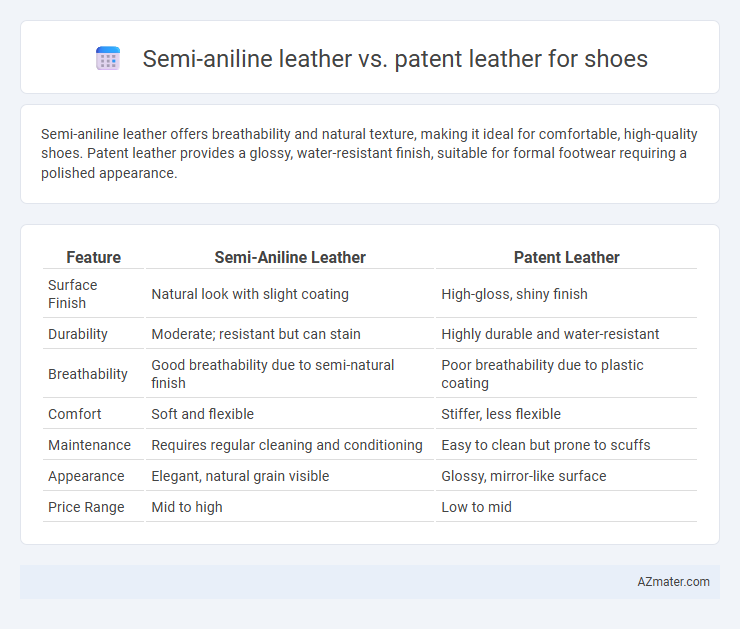Semi-aniline leather offers breathability and natural texture, making it ideal for comfortable, high-quality shoes. Patent leather provides a glossy, water-resistant finish, suitable for formal footwear requiring a polished appearance.
Table of Comparison
| Feature | Semi-Aniline Leather | Patent Leather |
|---|---|---|
| Surface Finish | Natural look with slight coating | High-gloss, shiny finish |
| Durability | Moderate; resistant but can stain | Highly durable and water-resistant |
| Breathability | Good breathability due to semi-natural finish | Poor breathability due to plastic coating |
| Comfort | Soft and flexible | Stiffer, less flexible |
| Maintenance | Requires regular cleaning and conditioning | Easy to clean but prone to scuffs |
| Appearance | Elegant, natural grain visible | Glossy, mirror-like surface |
| Price Range | Mid to high | Low to mid |
Introduction to Semi-Aniline and Patent Leather
Semi-aniline leather features a light protective coating that preserves the natural texture and breathability of the hide, offering a balance between durability and softness ideal for premium shoes. Patent leather is characterized by its high-gloss finish achieved through a lacquer or polyurethane coating, providing a striking, mirror-like shine and increased water resistance. Both materials cater to different aesthetic and functional preferences, with semi-aniline leather highlighting organic grain patterns and patent leather focusing on sleek, polished appearance.
Defining Semi-Aniline Leather
Semi-aniline leather retains natural characteristics by using a light, transparent dye and a thin protective coating, offering a balance between durability and softness ideal for shoe uppers. Patent leather features a high-gloss, durable polyurethane coating that creates a shiny, water-resistant finish but lacks the natural texture and breathability of semi-aniline materials. Shoes crafted from semi-aniline leather provide a more breathable and flexible fit, while patent leather excels in formal aesthetics and easy maintenance.
Defining Patent Leather
Patent leather is defined by its high-gloss, mirror-like finish achieved through a coating process that makes it water-resistant and easy to clean. Unlike semi-aniline leather, which maintains natural grain and breathability with minimal surface treatment, patent leather's synthetic coating offers durability and a polished appearance but sacrifices softness and flexibility. This makes patent leather ideal for formal shoes where shine and low maintenance are prioritized over natural texture.
Key Differences in Appearance
Semi-aniline leather shoes showcase a natural, matte finish with subtle texture variations and minimal surface coating, emphasizing the leather's organic grain and breathability. Patent leather shoes feature a high-gloss, reflective surface with a smooth, uniform appearance due to a thick plastic or lacquer coating that enhances durability but masks natural texture. The main visual distinction lies in semi-aniline leather's understated elegance versus patent leather's shiny, polished look ideal for formal occasions.
Durability and Wear Resistance
Semi-aniline leather offers moderate durability with a natural, breathable surface that ages well, showing scratches and scuffs less prominently due to its light protective coating. Patent leather provides superior wear resistance thanks to its high-gloss, polyurethane finish, making it highly resistant to water, stains, and abrasion but prone to cracking over time if not maintained. For long-lasting shoe use, patent leather excels in resisting daily wear and moisture, while semi-aniline leather emphasizes comfort and natural aesthetics with reasonable durability.
Comfort and Breathability Compared
Semi-aniline leather shoes offer superior comfort and breathability due to their minimal surface coating that maintains the leather's natural pores, allowing air circulation and moisture absorption. Patent leather, characterized by its glossy, impermeable finish, lacks breathability, often resulting in less comfort during extended wear due to trapped heat and moisture. Consequently, semi-aniline leather is preferred for footwear requiring enhanced comfort and ventilation.
Maintenance and Care Requirements
Semi-aniline leather requires careful maintenance, including regular cleaning with a damp cloth and conditioning to preserve its natural texture and prevent drying. Patent leather demands less frequent conditioning but needs gentle cleaning with a soft cloth and mild soap to maintain its shiny, glossy finish and avoid cracking. Both materials benefit from proper storage away from direct sunlight and moisture to prolong the shoe's lifespan.
Suitability for Various Shoe Types
Semi-aniline leather offers a natural finish with slight pigmentation, making it ideal for dress shoes and casual footwear due to its breathability and moderate durability. Patent leather's glossy, high-shine surface provides excellent water resistance and is best suited for formal shoes like oxfords and loafers, where a polished appearance is essential. Each leather type caters to different shoe styles, with semi-aniline favoring comfort and natural aesthetics, while patent leather emphasizes sleekness and protection.
Environmental and Ethical Considerations
Semi-aniline leather shoes involve less chemical processing and fewer synthetic dyes, reducing environmental pollution and preserving the leather's natural qualities. Patent leather shoes undergo extensive coating with synthetic polymers, producing a glossy finish but raising concerns over non-biodegradable waste and chemical runoff. Ethically, semi-aniline leather often comes from more transparent supply chains prioritizing sustainable practices, whereas patent leather production is typically linked to higher energy consumption and less eco-friendly manufacturing methods.
Conclusion: Choosing the Right Leather for Your Shoes
Semi-aniline leather offers a natural look, breathability, and soft feel, making it ideal for those valuing comfort and subtle elegance in shoes. Patent leather provides a high-gloss, durable surface that resists stains, perfect for formal occasions and statement footwear. Selecting between semi-aniline and patent leather depends on your preference for natural texture versus shiny finish, as well as the shoe's intended use and maintenance requirements.

Infographic: Semi-aniline leather vs Patent leather for Shoe
 azmater.com
azmater.com